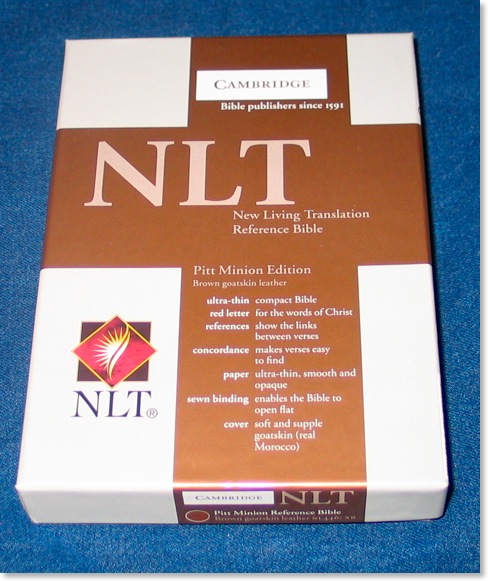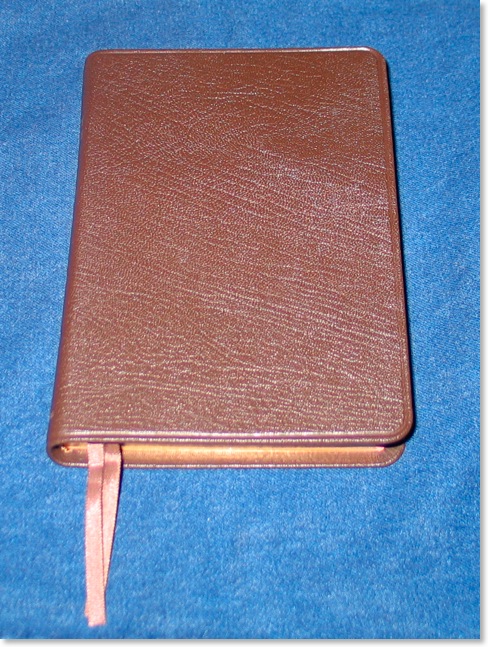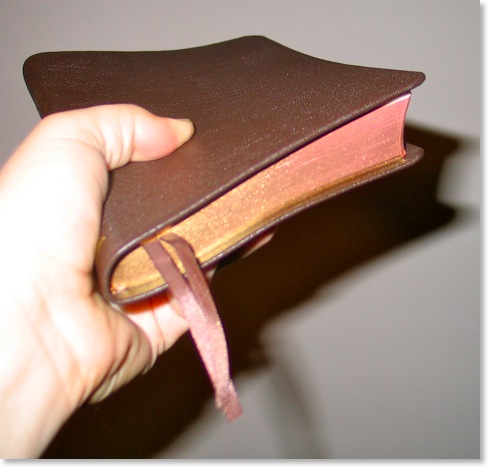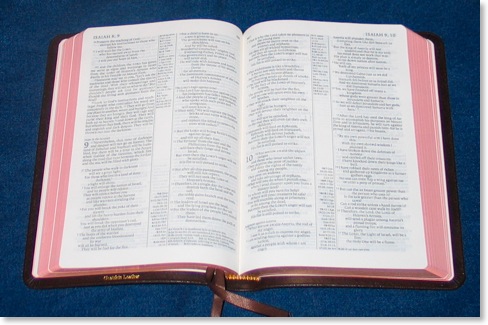 NOTE: This review has been a long time coming. I promised it well over a year and a half ago (two years ago?), but wanted to spend more time using the translation before writing about it. In August, 2007, I used the NET Bible exclusively for teaching and preaching in an attempt to familiarize myself with it even more. However, at the end of this time, I still felt I wasn’t ready to write the review. Then, in 2008, after beginning to write the review, the RapidWeaver file underlying This Lamp became corrupted and I lost all my work going back to October of the previous year. All work already published online I was able to recreate, but posts in progress were completely gone including my review of the NET Bible. In 2008, I spent another block of time using the NET Bible in near exclusivity to other translations when in public--this time for a period of approximately three months. Now, we're in the final quarter of 2009. I use the NET Bible regularly, but perhaps not as much as I could. And with the presumed release of the second edition in 2010, I partly wonder if a review of the first edition is even warranted. However, I remain enthusiastic about this translation and desire it to get as much exposure as possible. Although no translation is perfect, I do believe the NET Bible is an accurate translation, buoyed by the best set of textual notes I’ve ever seen in any Bible, period. It’s not as widely known as more “mainstream” translations, but I write this review with the hope of changing that. And I suggest that if any of my readers haven’t already done so, they should really give The NET Bible a try.
NOTE: This review has been a long time coming. I promised it well over a year and a half ago (two years ago?), but wanted to spend more time using the translation before writing about it. In August, 2007, I used the NET Bible exclusively for teaching and preaching in an attempt to familiarize myself with it even more. However, at the end of this time, I still felt I wasn’t ready to write the review. Then, in 2008, after beginning to write the review, the RapidWeaver file underlying This Lamp became corrupted and I lost all my work going back to October of the previous year. All work already published online I was able to recreate, but posts in progress were completely gone including my review of the NET Bible. In 2008, I spent another block of time using the NET Bible in near exclusivity to other translations when in public--this time for a period of approximately three months. Now, we're in the final quarter of 2009. I use the NET Bible regularly, but perhaps not as much as I could. And with the presumed release of the second edition in 2010, I partly wonder if a review of the first edition is even warranted. However, I remain enthusiastic about this translation and desire it to get as much exposure as possible. Although no translation is perfect, I do believe the NET Bible is an accurate translation, buoyed by the best set of textual notes I’ve ever seen in any Bible, period. It’s not as widely known as more “mainstream” translations, but I write this review with the hope of changing that. And I suggest that if any of my readers haven’t already done so, they should really give The NET Bible a try.
I personally know of only one person (Internet acquaintances excluded) who carries the NET Bible as his primary Bible... and I gave it to him. When the NET Bible First Edition (2005) was released, I eventually ordered a print copy (I already had it electronically in Accordance) and gave my “Second Beta Edition” print copy to a friend whom I meet for breakfast regularly. At the time he was carrying the NASB (and before that, the NKJV), but now whenever we meet for any kind of study or discussion about the Scriptures, he has his NET Bible. And he doesn’t bring it because I gave it to him; he carries it to church as well. His most profound testimony about the NET Bible goes something like this: “Every time our pastor goes into detail about what the original languages actually say, I look down at my NET, and it already says it, right there in the text.” Before some of you ask, his pastor preaches from the ESV. I suggested that my friend tell his pastor to switch to the NET Bible and potentially cut his sermons down by a third in length.
Allow me to offer another anecdote. In January of last year, a reader of This Lamp contacted me concerned over the TNIV reading of Job 16:20 (which happens to be word-for-word identical in the NET) as opposed to what he read in the ESV:
Job 16:20
|
RSV/NRSV/ESV
|
NET/NIV/TNIV
|
My friends scorn me;
my eye pours out tears to God, |
My intercessor is my friend
as my eyes pour out tears to God; |
The translation in the TNIV and NET Bible is not original; it can be found three decades ago in the NIV Bible, and in the Jerusalem Bible before that. However, to answer the question in the email required me to look beyond simple comparisons of translations or even a quick scan of the Hebrew. This kind of question usually sends someone to the commentaries and other reference works. But I’ve also found that in situations such as this, the notes in the NET Bible are quite helpful as a "first stop." To me notes in a study Bible should never be the final word on an issue, but much like a good encyclopedia, they should acts as a starting point in research. Over the last couple of years, whereas I might have turned to a commentary regarding translational differences described above or Metzger’s Textual Commentary for issues related to variants in the New Testament, I actually find myself looking in the notes of the NET Bible first (easily done in Accordance on my always-with-me MacBook Pro). I’ve found when looking for answers to these kinds of questions in the NET Bible, that it’s a rare occasion when I do not find what I am immediately looking for. And these notes are often amazingly complete. Consider the NET Bible’s explanation of Job 16:20, quoted above:
tn The first two words of this verse are problematic: מְלִיצַי רֵעָי (mélitsay re’ay, “my scorners are my friends” ). The word מֵלִיץ (melits), from or related to the word for “scorner” (לִיץ, lits) in wisdom literature especially, can also mean “mediator” (Job 33:23), “interpreter” (Gen 42:23). This gives the idea that “scorn” has to do with the way words are used. It may be that the word here should have the singular suffix and be taken as “my spokesman.” This may not be from the same root as “scorn” (see N. H. Richardson, “Some Notes on lis and Its Derivatives,” VT 5 [1955]: 434-36). This is the view of the NIV, NJPS, JB, NAB, as well as a number of commentators. The idea of “my friends are scorners” is out of place in this section, unless taken as a parenthesis. Other suggestions are not convincing. The LXX has “May my prayer come to the Lord, and before him may my eye shed tears.” Some have tried to change the Hebrew to fit this. The word “my friends” also calls for some attention. Instead of a plural noun suffix, most would see it as a singular, a slight vocalic change. But others think it is not the word “friend.” D. J. A. Clines accepts the view that it is not “friends” but “thoughts” (רֵעַ, rea’). E. Dhorme takes it as “clamor,” from רוּעַ (rua’) and so interprets “my claimant word has reached God.” J. B. Curtis tries “My intercessor is my shepherd,” from רֹעִי (ro’i). See “On Job’s Witness in Heaven,” JBL 102 [1983]: 549-62.
A note such as the above I find extremely helpful. The translational issue is explained. But beyond that, other interpretive alternatives are given as well as sources for further study (something other study Bibles rarely do). I rarely find this level of detail in study Bibles, but this kind of note is very much the norm for the NET Bible.
The notes in the NET Bible are organized around four categories: "translators’ notes (tn), study notes (sn), text-critical notes (tc), and map notes (map)." As seen in the note above with the reference to the article in The Journal of Biblical Literature, many of the extended notes have sources listed from academic books and journals so that a reader can pursue a subject further. Such references to external sources are extremely rare in study Bible notes.
A Representative Passage. The NET Bible can fairly be considered a median translation, literal when possible, but dynamic when necessary. I would place it slightly right of the NIV on the scale from formal on the left and dynamic on the right, but others may disagree.
Readers of This Lamp will know that I often praise the HCSB because of its technical accuracy. The same can usually be said of the NET Bible. I want to take a moment to look at the 23rd Psalm because I taught this passage at church yesterday and it's fresh in my mind. I was teaching from the HCSB, but aware that this passage is so familiar in the KJV, I was careful to compare differences in phraseology with the KJV, while keeping the Hebrew text as standard (it was kind of like biblical juggling). Granted, Psalm 23 in the KJV is unparalleled in terms of literary beauty. It's the translation I used to memorize this Psalm as a child, and it will always be with me. Having said that, however, the NET Bible, like the HCSB offers a clearer picture of what David was actually saying when he composed the psalm. And the NET Bible may even be better than the HCSB in this passage. I had limited time this past week for my preparation, but looking at the passage now in the NET Bible, it may have simply been my loss not to use it with my class yesterday.
PSALM 23 |
KJV
|
HCSB
|
NET Bible
|
The LORD is my shepherd;
I shall not want. |
The LORD is my shepherd;
there is nothing I lack. |
The LORD is my shepherd,
I lack nothing. |
He maketh me to lie down in green pastures:
he leadeth me beside the still waters. |
He lets me lie down in green pastures;
He leads me beside quiet waters. |
He takes me to lush pastures,
he leads me to refreshing water. |
He restoreth my soul:
he leadeth me in the paths of righteousness for his name’s sake. |
He renews my life;
He leads me along the right paths
for His name’s sake. |
He restores my strength.
He leads me down the right paths
for the sake of his reputation. |
Yea, though I walk through the valley of the shadow of death,
I will fear no evil:
for thou art with me;
thy rod and thy staff they comfort me. |
Even when I go through the darkest valley,
I fear |no| danger,
for You are with me;
Your rod and Your staff—they comfort me. |
Even when I must walk through the darkest valley,
I fear no danger,
for you are with me;
your rod and your staff reassure me. |
Thou preparest a table before me in the presence of mine enemies:
thou anointest my head with oil;
my cup runneth over. |
You prepare a table before me
in the presence of my enemies;
You anoint my head with oil;
my cup overflows. |
You prepare a feast before me
in plain sight of my enemies.
You refresh my head with oil;
my cup is completely full. |
Surely goodness and mercy shall follow me all the days of my life:
and I will dwell in the house of the LORD for ever. |
Only goodness and faithful love will pursue me
all the days of my life,
and I will dwell in the house of the LORD
as long as I live. |
Surely your goodness and faithfulness will pursue me all my days,
and I will live in the LORD’s house for the rest of my life. |
Take, for instance, v. 1b. Much has been written about the KJV's "I shall not want" as a phrase that no longer communicates the intent of the writer. Essentially, David is saying that he will not be in need of anything because Yahweh is his shepherd. The KJV can be misinterpreted by contemporary audiences to mean, "I follow God and I won't want anything." The HCSB renders this more accurately with "there is nothing I lack," however, the NET Bible's active voice in "I lack nothing" is simple, straight to the punch and makes for a slightly clearer understanding.
In v. 2a yes, דֶּשֶׁא can be literally translated "green," but that's not quite the point, and one that might be missed by readers in more fertile areas, such as many places in North America. The NET Bible's "lush" pastures captures the intended meaning much better for a contemporary western reader.
On the other hand, the accuracy of the NET Bible's "refreshing" (מְנוּחָה) waters in 2b may be debatable. In the analogy of a shepherd and his sheep, from my understanding, it's the quiet or still waters--as opposed to more treacherous, rushing water--that provides a sheep the safety of receiving refreshing water.
The KJV's rendering of "he leadeth me in paths of righteousness" (3b) is not technically inaccurate; however, it strays from the metaphor of the shepherd and sheep. צֶדֶק/tsedeq is most often translated as righteousness, but it can also be translated right as seen above in both the HCSB and NET Bible. The use of right paths retains the metaphor of the shepherd leading sheep down the correct, well known paths to safe pasture. The application of this for the reader is that Yahweh does, in fact, lead one on paths of righteousness. The connection would be more clear to the original readers, of course, but "right paths" helps to retain David's original implication and preserve the overlying metaphor.
I spent time yesterday explaining that "for his name's sake" meant "for the sake of his reputation." Perhaps if I'd just used the NET Bible yesterday to begin with, I wouldn't have gone overtime!
In v. 4d, the NET Bible breaks with the traditional "comfort" with "your rod and your staff reassure me." There is a textual note that explains the change: "The Piel of נָחַם (nakham), when used with a human object, means 'comfort, console.' But here, within the metaphorical framework, it refers to the way in which a shepherd uses his implements to assure the sheep of his presence and calm their nerves. The underlying reality is the emotional stability God provides the psalmist during life threatening situations." I concur with the NET Bible translators, especially having to take the time yesterday to explain the same thing.
The NET Bible's "You prepare a feast before me in plain sight of my enemies" (5a-b) much better communicates the meaning than simply preparing "a table." I also like "in the plain sight" rather than "in the presence of" as it more accurately communicates the meaning of the original text.
I also took the time yesterday to explain that "You anoint my head with oil" (5c) related to the practice of using oil to freshen one's skin and protect it from the dry weather of Israel. The NET Bible captures this idea of hospitality with "You refresh my head with oil." Granted, some of the Davidic aspect of the symbolic anointing of the king may be lost (something that would not have been lost by the original readers), but "refreshing" keeps with the second metaphor of the psalm, that of the lavish hospitality shown to an honored guest.
"My cup is completely full" is another one of these technical accuracies over against the KJV's "my cup runneth over" or even the HCSB's "my cup overflows." According to the NET Bible's note with this section, "The rare noun רְַָויָה (révayah) is derived from the well-attested verb רָוָה (ravah, “be saturated, drink one’s fill” ). In this context, where it describes a cup, it must mean “filled up,” but not necessarily to overflowing."
Granted, the NET Bible does not have the literary beauty of the KJV (neither do most modern translations), but for the modern reader, it is much more clear in its representation of the biblical text and its original meaning. The examples above, especially with the explanatory detail of the accompanying notes, demonstrate why I recommend the NET Bible to every student of the Bible. Even if it is not used as one's primary translation, it is an excellent comparative companion Bible for understanding a biblical passage.
History and Purpose of the NET Bible. As with any translation, to get a sense of background and purpose for the text, I highly recommend reading the preface and introduction of the NET Bible (see also Hall Harris' "Early Origins of the NET Bible"). The NET Bible's origins go back to a meeting at SBL in 1995 in which a group of scholars got together to discuss the need for a translation of the Bible to be used in electronic form on the internet. It may be difficult for some folks to remember the "wild west days" of the world wide web, back in the nineties, but it was very unclear at that time how copyright laws of standard Bible translations applied to use on the internet. For the most part, this was also before modern translations of the Bible were easily accessible on sponsored websites.
NET, is both an acronym for "New English Translation" and a play on 'net, short for internet. Early editions of the NET Bible were released as "beta" editions with the first beta released in 2001 and the second in 2003. This makes me wonder why the first "final" edition was called a "first edition" when released in 2005. In keeping with the pattern earlier established, it could have been called "1.0" with the next edition released as "2.0" and so forth. According to the introduction of the NET Bible, "The biblical text of the NET Bible itself will be revised in five-year increments beginning in 2010... ."
The translators of the NET Bible make the claim that "we posted the NET Bible on the Internet when no other major modern English Bible translations had done so ... but after 10 years, the NET Bible is still the only major modern translation that can be downloaded for free in its entirety and used seamlessly in presentations and other documents." They basically take a "YES" position in regard to permission to use the NET Bible in publications or on the internet for "the vast majority of requests." This is called a "Ministry First" permissions policy.
Although the NET New Testament is based upon the NA27 Greek text, the translators opted for alternative readings 126 times (by my count), indicated in the notes by a double dagger [‡].
A glance at the translators' page in the NET Bible displays a heavy influence from Dallas Theological Seminary. Thus, the NET Bible surprises one at times when it is not as traditional as preconceptions might suggest. One such example is in 1 Tim 2:5 which is mentioned in the next section. Another is in Isa 7:14 where the NET, like the NRSV translates עַלְמָה/almah as young woman instead of virgin:
"For this reason the sovereign master himself will give you a confirming sign. Look, this young woman is about to conceive and will give birth to a son. You, young woman, will name him Immanuel."
This rendering is surprising after all the ink used over the past few decades regarding young woman vs. virgin. Of course, to most readers--even very conservative ones--who are familiar with the underlying issues of the relationships among the Hebrew Bible, LXX, and New Testament, the use of young woman is really a non-issue. But the average conservative Christian is not always aware of these issues. Even the translators of major recent versions (ESV, HCSB, NLT, TNIV) have retained the more traditional virgin in Isa 7:14. I'm certain that the translators of these other version are well-familiar with the issues surrounding the passage, but my guess is they are more concerned about the potentially negative response from the Bible reader who doesn't understand the change in wording or underlying issues. The memory of controversy surrounding the original 1952 RSV is, evidently, not distant enough.
Nevertheless, this is where the advantage of the NET Bible's extensive footnotes come into play. I've never seen anyone, after having the issue explained, still reject the use of young woman. Here is the NET Bible note for "young woman":
Traditionally, “virgin.” Because this verse from Isaiah is quoted in Matt 1:23 in connection with Jesus’ birth, the Isaiah passage has been regarded since the earliest Christian times as a prophecy of Christ’s virgin birth. Much debate has taken place over the best way to translate this Hebrew term, although ultimately one’s view of the doctrine of the virgin birth of Christ is unaffected. Though the Hebrew word used here (עַלְמָה, ʾalmah) can sometimes refer to a woman who is a virgin (Gen 24:43), it does not carry this meaning inherently. The word is simply the feminine form of the corresponding masculine noun עֶלֶם (ʾelem, “young man”; cf. 1 Sam 17:56; 20:22). The Aramaic and Ugaritic cognate terms are both used of women who are not virgins. The word seems to pertain to age, not sexual experience, and would normally be translated “young woman.” The LXX translator(s) who later translated the Book of Isaiah into Greek sometime between the second and first century B.C., however, rendered the Hebrew term by the more specific Greek word παρθένος (parthenos), which does mean “virgin” in a technical sense. This is the Greek term that also appears in the citation of Isa 7:14 in Matt 1:23. Therefore, regardless of the meaning of the term in the OT context, in the NT Matthew’s usage of the Greek term παρθένος clearly indicates that from his perspective a virgin birth has taken place.
Ultimately, renderings such as those found in Isa 7:14 and 1 Tim 2:5 (below) in the NET Bible speak to the translators' faithfulness to the original language texts over and above any bias rooted in traditionalism or ideology.
"Gender Accuracy." I can't remember whether I first came across the term "gender accuracy" from the NET Bible team or in the preface of the TNIV. Regardless, the translators explain the terms in this manner: "With the NET Bible our concern was to be gender-accurate rather than gender-inclusive, striving for faithfulness to the original biblical texts while at the same time seeking to attain accuracy in terms of current English style." The end result is a Bible translation that is more inclusive than the ESV or HCSB, but less so than the NRSV, NLT, or TNIV.
So, for instance, the NET Bible will render ἀδελφοί/adelphoi in Romans 1:13 (and other similar verses) as "brothers and sisters" as do the NLT and TNIV. The ESV merely offers a footnote explaining why "brothers and sisters" is a valid translation for the context, but the HCSB offers no note at all.
The NET Bible renders ἄνθρωπος/anthropos in 1 Tim 2:5 as humanity: "For there is one God and one intermediary between God and humanity, Christ Jesus, himself human" because the emphasis is not on Jesus' maleness in this verse, but his identification with the human race.
On the other hand, the NET Bible is less inclusive than translations like the NRSV, NLT, and TNIV in verses such as Rev 3:20 (a notoriously difficult verse to make gender inclusive):
Rev 2:20 (emphasis added) |
Ἰδοὺ ἕστηκα ἐπὶ τὴν θύραν καὶ κρούω· ἐάν τις ἀκούσῃ τῆς φωνῆς μου καὶ ἀνοίξῃ τὴν θύραν, [καὶ] εἰσελεύσομαι πρὸς αὐτὸν καὶ δειπνήσω μετ᾿ αὐτοῦ καὶ αὐτὸς μετ᾿ ἐμοῦ. |
NRSV
|
NLT
|
TNIV
|
NET Bible |
Listen! I am standing at the door, knocking; if you hear my voice and open the door, I will come in to you and eat with you, and you with me. |
“Look! I stand at the door and knock. If you hear my voice and open the door, I will come in, and we will share a meal together as friends. |
Here I am! I stand at the door and knock. If anyone hears my voice and opens the door, I will come in and eat with them, and they with me. |
Listen! I am standing at the door and knocking! If anyone hears my voice and opens the door I will come into his home and share a meal with him, and he with me. |
In the above example, the NRSV changes the pronoun from third to second person to avoid a masculine pronoun. The NLT does this and then paraphrases the last part of the verse in avoidance of a masculine pronoun. The TNIV employs the informal "singular they." But the NET Bible chooses none of these options and offers a more traditional masculine universal so as to keep the pronoun in third person. I doubt they're concerned as much about the pronoun's gender as they are with changing the person number of the pronoun.
Weaknesses. Almost everyone who spends time with the NET Bible comes away praising its 60,932 notes, but reviews of the translation itself seem to be mixed. My feeling has been that the translation itself falls a bit flat on my ears, somewhat like the original NIV. Having said that, however, I find that the more I use the NET Bible, the more it grows on me.
According to the Net Bible's preface, the translation is intended to be "readable and accurate and elegant all at the same time." Dan Wallace often refers to the NET Bible as elegant--see here and here). I have no dispute with the characteristics of readable and accurate. The issue of elegance probably leaves the most to be desired. But I may not be the right person to judge as I rarely consider modern translations to be all that elegant (the REB is certainly an exception).
Any translation can be nitpicked, and that is not my goal here. Sometimes certain phrasings stand out. I've noticed that for the traditional phrase "fear the LORD," the NET Bible uses three different phrases according to context: (1) fear the LORD, (2) revere (or reverence for) the LORD and (3) respect (or respect for) the LORD. Of course, the phrase can be difficult for a modern audience. I always say that both "healthy" and "unhealthy" fear exists for God, and the Bible is usually referring to the former. "Respect the LORD" in Hag 1:12 seems to lack impact. I find these kinds of "weak" phrasings now and then in the NET Bible in which I believe the translation could be a little bit stronger, but it's not a prevalent issue.
Like the ESV and the HCSB (2009 text), the NET Bible rephrases Rom 16:7 so that Andronicus and Junia are not among the apostles, but rather as ones known to the apostles, breaking with traditional understanding of the verse as well as church history/tradition. The issue, of course, is whether or not Junia--a woman--could be considered an apostle. Many older translations even changed her name to Junias (a masculine name) in avoidance of this issue. History says very little about Andronicus and Junia, although most tradition comes from the Eastern Church who refers to her as "equal to the apostles."
Ultimately, there's not enough history to definitively say. I have high regard for Dan Wallace and his scholarship, but even after reading his article on the subject (twice), I'm still not convinced of the validity of changing "among the apostles" to "known to the apostles." And I say that as a complementarian, but as one not threatened by the idea of a female apostle any more than I'd be threatened by a female judge (such as Deborah, Judges 4-5) or a female prophet (such as Huldah, 2 Kings 22:14 or the daughters of Philip, Acts 21:8-9).
Also the note for "day" (יוֹם/yom) in Gen 1:5ff leaves no room for the days of creation as anything other than literal 24 hour periods, in spite of many conservative Christians who would hold to an interpretation of long eras for the days of creation. I don't begrudge the translators the right to their own interpretation, but to not even mention other options surprises me, especially since it is often done elsewhere.
I've heard others claim before that some of the notes in the NET Bible have somewhat of a Dispensational flavor at times. I admit that I have not come across any that do in my use of the NET Bible. Overall, with a couple of exceptions noted above, I find the notes to be very balanced.
In the printed edition of the standard NET Bible (the edition with the full set of 60,932 notes), the layout of the biblical text leaves something to be desired. While there is paragraphing, every verse also has its chapter number, too. So John 3:16 has the full "3:16" in front of the text as do all other verses. Thus, it looks somewhat like a text exported from a computer and then not cleaned up. More than likely this was the case. The "Reader's Edition" has the same quality, but the text was cleaned up for the Greek/English diglot.
Another (very minor) nitpick of mine relates to the titles of biblical books used on their initial pages. The font is called "Papyrus" on my Mac. Somehow, it seems a bit out of place in my printed copies of the full edition and the Reader's Edition (it is not used in the diglot). I get that it's being used because the Bible is an ancient document, but somehow it comes across to me as a bit amateurish on the part of the publishers.
The NET Bible's maps are actually spectacular satellite images of the Holy Land with an overlay of site designations. While these are magnificent images, and help to remind the reader that the events of the Bible took place in an actual terrestrial location, they aren't as much use for actual study. Due to their nature as satellite photos, the pictures' orientation (that is, the direction in which they are turned) often presents the map in a direction other than vertical north. When I've had the printed edition of the NET Bible with me, I've often had to borrow someone else's Bible with more traditionally laid out maps to get a better bearing on geographical issues.
Various Editions. As seen at the Bible.org store webpage, the NET Bible comes in a variety of editions: First edition with full 60,932 notes, a Reader's Edition with fewer notes, a Greek/English diglot, a compact edition (also with fewer notes), an audio Bible, and electronic versions. And, as already mentioned, the NET Bible can be downloaded for free.
I most often use the NET Bible in Accordance (which I notice is not listed on Bible.org's online store listing electronic editions). However, I also have made fairly regular use of the print copies I have. I had a copy of the second beta edition early which I gave away after the full first edition was published. I've carried this first edition with me a number of times, and have taught from it in public. A better option for public use is the Reader's Edition which has a very large font (11 pt.) and much fewer notes than the regular edition. The Reader's Edition I have was given to me by an employee of Bible.org a while back, and I have both taught and preached from it publicly. All other editions of the NET Bible, I have paid for on my own.
The Greek/English diglot New Testament is by far the best diglot of any I've ever seen or used. The Greek text is the standard Nestle-Aland 27th edition, but with large print. The English text has a very readable print as well, larger than the regular edition, and perhaps larger than the Reader's Edition. There is room in the margins for personal notes, especially at the bottom of pages.
I have found it very interesting that with the printed editions of the NET Bible I have, all three have a separate set of notes. The Greek/English diglot's set of notes is intriguing because just as the Greek New Testament's apparatus will compare the accepted text with variants, the English text in the diglot often has notes comparing other English translations as well explanations bridging the text from Greek to English.
An example of the differences in notes between these editions can be illustrated in John 2:4:
Jesus replied,10/-/3 "Woman,11/j/- why are you saying this to me?12/-/4 My time13/k/5 has not yet come" (John 2:4, NET Bible) |
Standard Edition (with 60,932 notes)
|
Reader's Edition
|
Greek/English Diglot
|
10 tn Grk "and Jesus said to her."
11 sn The term Woman is Jesus' normal, polite way of addressing women (Matt 15:28, Luke 13:12; John 4:21; 8:10; 19:26; 20:15). But it is unusual for a son to address his mother with this term. The custom in both Hebrew (or Aramaic) and Greek would be for a son to use a qualifying adjective or title. Is there significance in Jesus' use here? It probably indicates that a new relationship existed between Jesus and his mother once he had embarked on his public ministry. He was no longer or primarily only her son, but the "Son of Man." This is also suggested by the use of the same term in 19:26 in the scene at the cross, where the beloved disciple is "given" to Mary as her "new" son.
12 tn Grk "Woman, what to me and to you?" (an idiom). The phrase τί ἐμοὶ καὶ σοί, γύναι (ti emoi kai soi, gunai) is Semitic in origin. The equivalent Hebrew expression in the Old Testament had two basic meanings: (1) When one person was unjustly bothering another, the injured party could say "What to me and to you?" meaning, "What have I done to you that you should do this to me?" (Judg 11:12, 2 Chr 35:21, 1 Kgs 17:18). (2) When someone was asked to get involved in a matter he felt was no business of his, he could say to the one asking him, "What to me and to you?" meaning, "That is your business, how am I involved?" (2 Kgs 3:13, Hos 14:8). Option (1) implies hostility, while option (2) implies merely disengagement. Mere disengagement is almost certainly to be understood here as better fitting the context (although some of the Greek Fathers took the remark as a rebuke to Mary, such a rebuke is unlikely).
13 tn Grk "my hour" (referring to the time of Jesus' crucifixion and return to the Father).
sn The Greek word translated time (ὥρα, hōra) occurs in John 2:4; 4:21, 23; 5:25, 28, 29; 7:30; 8:20; 12:23, 27; 13:1; 16:25; and 17:1. It is a reference to the special period in Jesus' life when he was to leave this world and return to the Father (13:1); the hour when the Son of man is glorified (17:1). This is accomplished through his suffering, death, resurrection (and ascension — though this last is not emphasized by John). John 7:30 and 8:20 imply that Jesus' arrest and death are included. John 12:23 and 17:1, referring to the glorification of the Son, imply that the resurrection and ascension are included as part of the "hour." In John 2:4 Jesus' remark to his mother indicates that the time for this self-manifestation has not yet arrived; his identity as Messiah is not yet to be publicly revealed. |
j Grk Woman, what is that to me and to you? (an idiom)
k Grk hour |
3 Grk "and Jesus said to her" (so NASB, NRSV)
4 Grk "Woman, what to me and to you?" This is an idiom meaning "We have nothing to do with one another," or "Why bother us!" (cf. BDAG 275 s.v. ἐγώ). The equivalent Hebrew expression in the OT had two basic meanings: (1) "What have I done to you that you should do this to me? (Judg 11:12, 2 Chr 35:21; 1 Kgs 17:18). (2) "That is your business, how am I involved?" (2 Kgs 3:13; Hos 14:8) Option (1) implies hostility, while (2) merely implies disengagement. Mere disengagement is almost certainly to be understood from the context here (although some of the Greek Fathers took the remark as a rebuke to Mary, such a rebuke is unlikely).
5 Grk "my hour" (so RSV, NAB, NASB, NRSV), referring to the time of Jesus' crucifixion and return to the Father. |
A Bible in Need of Widespread Exposure. I’ve never seen the NET Bible in any bookstore whether independent or chain, Christian or non-Christian. Every once in a while, I hear of a store carrying the NET Bible, but this has always been in an independent store in which the owner or Bible buyer was familiar with the NET Bible. Most people I know who use the NET Bible at all, use it on the internet or through Bible software. But that’s not enough. I would really like to see the NET picked up by some national distributor so that more people could be exposed to this translation. Many of the people I recommend Bibles to at church prefer to look at a selection at a store at least as a first step toward buying a Bible.
An enterprising individual--whether starting a church or simply organizing a new group Bible study--could buy a number of NET Bibles (there are offers for buying them in "packs" on the Bible.org store website) and create a common base translation for all involved.
Ultimately, I recommend the NET Bible--especially the standard edition with 60,932 notes--to all believers. The detailed notes are clearly one of the best first stops (and in many cases will be final answer) in asking questions of the biblical text. The more I've used the NET Bible, both personally and publicly, the more I both like and respect it. My original "top ten" list of Bible translations is now dated. At the time, I didn't know the NET Bible well enough to include it, but if I were making the list over today, I'd easily place the NET Bible in the top five.
See also
NET Bible on Bible.org
NET Bible Store
NET Bible Revolution Blog
 Monday, October 12, 2009 at 2:57PM
Monday, October 12, 2009 at 2:57PM  Writing today in "A Personal Note on the NIV 2011," at Zondervan Academic's Koinonia blog, Bill Mounce announced that he is joining the NIV Committee on Bible Translation. His joining came at the invitation of other CBT memmbers, Douglas Moo and Mark Strauss.
Writing today in "A Personal Note on the NIV 2011," at Zondervan Academic's Koinonia blog, Bill Mounce announced that he is joining the NIV Committee on Bible Translation. His joining came at the invitation of other CBT memmbers, Douglas Moo and Mark Strauss. CBT,
CBT,  ESV NIV,
ESV NIV,  TNIV in
TNIV in  Faith & Reason
Faith & Reason 





 Long ago, the body of Christ recognized that the Canon of Scripture is closed. Thus, no matter how inspiring a Christian voice can be—such as Martin Luther King Jr. in "Letter from a Birmingham Jail"—we don't tack that on in our Bibles somewhere after the Book of Revelation. I understand that. But at the same time many contemporary Christians completely miss out on the voices of other believers from the past two millennia since the Bible was written. Often this comes from simply not having an easy way to access them.
Long ago, the body of Christ recognized that the Canon of Scripture is closed. Thus, no matter how inspiring a Christian voice can be—such as Martin Luther King Jr. in "Letter from a Birmingham Jail"—we don't tack that on in our Bibles somewhere after the Book of Revelation. I understand that. But at the same time many contemporary Christians completely miss out on the voices of other believers from the past two millennia since the Bible was written. Often this comes from simply not having an easy way to access them.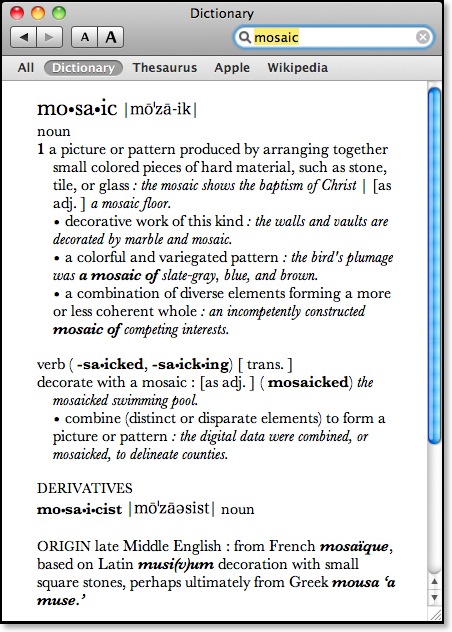
 Just as the readings represent a wide diversity from history and location, so does the artwork. I was especially struck by the painting on p. 80 shown to the left. It is a depiction of the parable of the Lost Son by an unknown artist in Hong Kong. This image goes with the readings for Epiphany, week 6: "Seeking and Saving." And yet, the nature of the painting itself, with Asian style and imagery reminds us that Christianity isn't limited to our own culture and thought.
Just as the readings represent a wide diversity from history and location, so does the artwork. I was especially struck by the painting on p. 80 shown to the left. It is a depiction of the parable of the Lost Son by an unknown artist in Hong Kong. This image goes with the readings for Epiphany, week 6: "Seeking and Saving." And yet, the nature of the painting itself, with Asian style and imagery reminds us that Christianity isn't limited to our own culture and thought.












